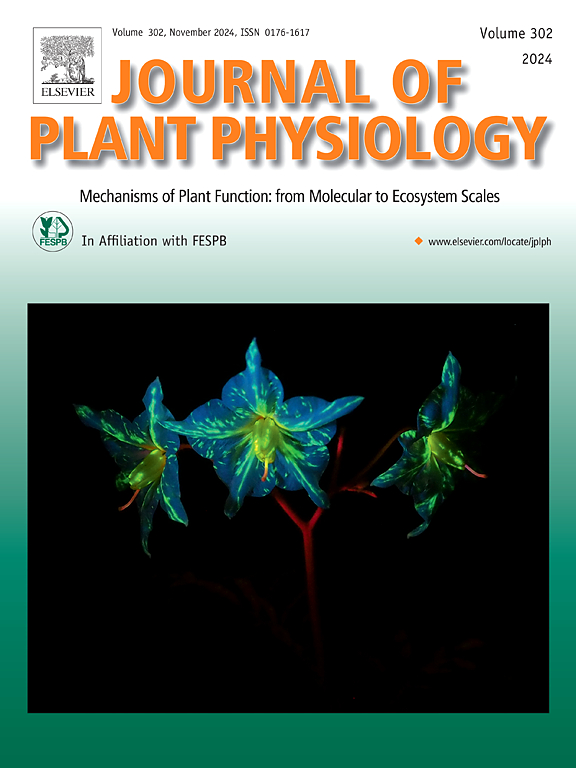干旱诱导的基生叶仙人掌抗氧化能力、矿物质含量和植株发育的变化:细叶仙人掌和巴希仙人掌的比较
IF 4.1
3区 生物学
Q1 PLANT SCIENCES
引用次数: 0
摘要
牛蒡以其高含量的蛋白质、矿物质、维生素和生物活性化合物而闻名,使其成为一种非传统的食物。相比之下,P. bahiensis的营养潜力仍然很少被探索。干旱和防御相关的生物调节剂如水杨酸(SA)和硝普钠(SNP)可以影响植物的组成和抗氧化反应,但它们对Pereskia物种的影响尚不清楚。本研究旨在评估水分亏缺、SA和SNP处理下,斑马草和巴希巴草的生长和营养状况,测试巴希巴草是否也具有食物潜力,以及这些处理是否增强了抗氧化能力。为此,植物在两种灌溉制度下生长:水分充足(80%保水能力- WRC)和水分不足(15% WRC) 8天,然后是16天的完全限水。此外,叶面喷施100 μM SA、100 μM SNP或水(对照)。巴伊木的酚类化合物含量和抗氧化能力均高于马齿苋,但生物量、糖和矿物质含量均低于马齿苋。干旱提高了两种植物的抗氧化能力,但降低了矿物质含量和生物量;SA和SNP只影响锰含量,不影响抗氧化能力和生长。这些发现突出了巴希巴木具有很强的抗氧化能力,其抗氧化能力超过了刺叶巴木,这凸显了巴希巴木作为营养保健植物的潜力。此外,水分亏缺可以作为提高两种植物抗氧化能力的策略,而SA和SNP处理对其质量没有影响。本文章由计算机程序翻译,如有差异,请以英文原文为准。

Drought-induced changes in antioxidant capacity, mineral content, and plant development in basal leafy cactus: comparisons between Pereskia aculeata miller and Pereskia bahiensis Gürke
Pereskia aculeata is known for its high levels of proteins, minerals, vitamins, and bioactive compounds, qualifying it as an unconventional food. In contrast, the nutritional potential of P. bahiensis remains much less explored. Drought and defense-related bioregulators like salicylic acid (SA) and sodium nitroprusside (SNP) can influence plant composition and antioxidant responses, but their effects on Pereskia species are still unclear. This study aimed to assess the growth and nutritional profiles of P. aculeata and P. bahiensis under water deficit, SA, and SNP, testing whether P. bahiensis also holds food potential and whether these treatments enhance antioxidant capacity. For this, plants were grown under two irrigation regimes: well-watered (80 % water retention capacity – WRC) and water deficit (15 % WRC for 8 days, followed by total water restriction for 16 days). Additionally, plants were foliar sprayed with 100 μM SA, 100 μM SNP, or water (control). P. bahiensis exhibited greater phenolic compounds content and antioxidant capacity, but lower biomass production, and contents of sugars and minerals compared to P. aculeata. Drought increased the antioxidant capacity but decreased mineral content and biomass in the two species; while SA and SNP only affected Mn contents, not affecting the antioxidant capacity and growth. These findings highlight the great antioxidant capacity of P. bahiensis, surpassing that of P. aculeata, which underscores its potential as a nutraceutical plant. Moreover, water deficit can be used as a strategy to improve antioxidant capacity of both species, while SA and SNP treatments have no effects in their quality.
求助全文
通过发布文献求助,成功后即可免费获取论文全文。
去求助
来源期刊

Journal of plant physiology
生物-植物科学
CiteScore
7.20
自引率
4.70%
发文量
196
审稿时长
32 days
期刊介绍:
The Journal of Plant Physiology is a broad-spectrum journal that welcomes high-quality submissions in all major areas of plant physiology, including plant biochemistry, functional biotechnology, computational and synthetic plant biology, growth and development, photosynthesis and respiration, transport and translocation, plant-microbe interactions, biotic and abiotic stress. Studies are welcome at all levels of integration ranging from molecules and cells to organisms and their environments and are expected to use state-of-the-art methodologies. Pure gene expression studies are not within the focus of our journal. To be considered for publication, papers must significantly contribute to the mechanistic understanding of physiological processes, and not be merely descriptive, or confirmatory of previous results. We encourage the submission of papers that explore the physiology of non-model as well as accepted model species and those that bridge basic and applied research. For instance, studies on agricultural plants that show new physiological mechanisms to improve agricultural efficiency are welcome. Studies performed under uncontrolled situations (e.g. field conditions) not providing mechanistic insight will not be considered for publication.
The Journal of Plant Physiology publishes several types of articles: Original Research Articles, Reviews, Perspectives Articles, and Short Communications. Reviews and Perspectives will be solicited by the Editors; unsolicited reviews are also welcome but only from authors with a strong track record in the field of the review. Original research papers comprise the majority of published contributions.
 求助内容:
求助内容: 应助结果提醒方式:
应助结果提醒方式:


